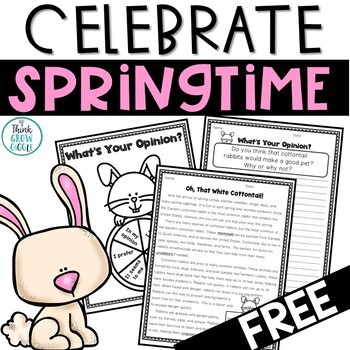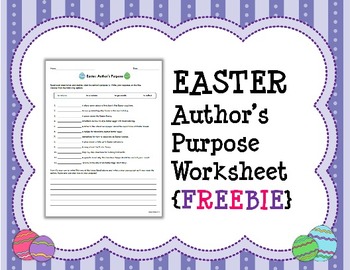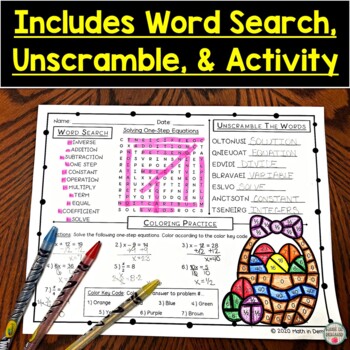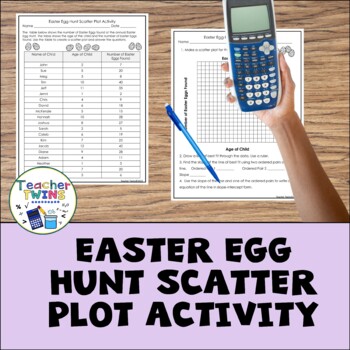
We’ve curated these Easter activities for the classroom as a resource for educators to bring the Easter spirit into class while helping students build their reading, writing, and math skills! Celebrating holidays like Easter in the classroom connects students from different cultures and backgrounds. By incorporating the holiday into the school day through themed activities, such as the ones throughout this page, teachers are providing a space for students to enjoy a celebration while practicing key skills for school.
We’ve also included quizzes developed by Piqosity’s team of educators, including an Easter-themed passage with original comprehension questions and three original holiday-themed math questions (complete with an answer key). This year, Easter falls on Sunday, April 20th—keep reading to see how your classroom can celebrate in the days before and after.
ELA Easter Activities for the Classroom
The following Easter activities for the classroom, covering a variety of ELA subtopics, are sure to enhance your students’ reading and writing skills. Moldable to any classroom and ordered from lower-level to higher-level, they call upon students for their creativity and their critical thinking skills!
1. Springtime Bunny Reading and Writing Activities
These Easter activities for kids help them practice their reading and writing skills in more ways than one! Included is a nonfiction passage about the cottontail rabbit with comprehension questions, a chart for students to fill out, identifying the difference between fact and opinion, and a writing prompt that lets them explore their own opinions.
Printable and available as an online activity, this ELA resource for elementary students helps them practice their close reading skills while they have fun.
Created and made available for free download by Think Grow Giggle.
2. Easter Author’s Purpose Activity
This worksheet, best for middle- and high-schoolers, tasks students with identifying the author’s purpose in several Easter-themed text ideas (such as a recipe for eggs, a poem about Easter, a speech about candy, etc.). Then, students are asked to write about one of the text ideas and keep their purpose in mind.
A great way to have students creatively practice key ELA skills, this Easter activity for teens is great in both physical and virtual formats.
Created and made available for free download by Mainly Middle School 6-8.
3. Grammatical Easter Egg Hunt
Find that your middle or high school students are struggling with grammar in their essays and other assignments? This Easter activity is sure to help. The only prep is to print the “sentences” sheet, cut the sentences out, and place them in Easter eggs. Students are then tasked with opening each Easter egg, reading the sentence, and identifying the grammar mistakes by writing them down on their own worksheet.
This resource, made for Google Drive, covers several grammar concepts, including comma rules, semicolon use, dialogue, and so on—it’s a fun way to help your students remember common grammar mistakes and rules that will help them in their own writing process.
Created and made available for free download by Book Nerd English Teacher.
Math Easter Activities for the Classroom
Next up—each of the following free, fun math Easter activities for the classroom is more challenging and captivating than the last! Covering basic operations, geometry, or graphing, these worksheets are perfect for distribution at any point in your class day.
1. Free Easter Math Worksheet – 3 Digit Subtraction
The first math activity we’re spotlighting is perfect for classes that could use some subtraction practice this April. A printable resource perfect for independent practice, this free Easter worksheet quizzes students on their ability to subtract with three-digit numbers.
If you want to get students extra eager to participate with some friendly competition, you can even distribute it as a race to see which students can solve all the problems the fastest!
Created and made available for free download by Copper Classroom.
2. Fun Easter Activities – Math Vocabulary and Practice
This resource is full of various Easter-themed math activities that help your students practice key skills and terms while having fun! Three different sheets are included, each with a word search, a word unscrambling task, and math problems with a coloring component.
Whether your current curriculum involves solving equations, graphing, or geometry, there’s an activity sheet for each topic! Students are sure to enjoy this activity, which is perfect for homework or independent work for early-finishers.
Created and made available for free download by Math in Demand.
3. Easter Egg Hunt – Scatter Plot Activity
The last of these printable Easter activities, this scatter plot worksheet is a great way to have your students celebrate Easter while practicing their Algebra skills.
Provided is a data sheet of egg hunt–related figures that students are asked to plot onto a coordinate grid. Then, students will draw a graph based on the data points and explore its slope, resulting in their creation of a slope-intercept form equation. This resource is a fun way to introduce students to or have them practice such concepts!
Created and made available for free download by Teacher Twins.
Easter Reading Comprehension Quiz
The best way for students to improve their ELA and reading skills, especially in preparation for standardized tests, is with practice. As a reading comprehension exercise for this egg-themed holiday, the Piqosity team has selected a passage that looks at the mathematics behind eggs, invest-egg-ating the different applications of math and types of bird eggs!
Excerpt from “Can a Mathematical Formula Describe Types of Bird Eggs?” by Amanda Maxwell
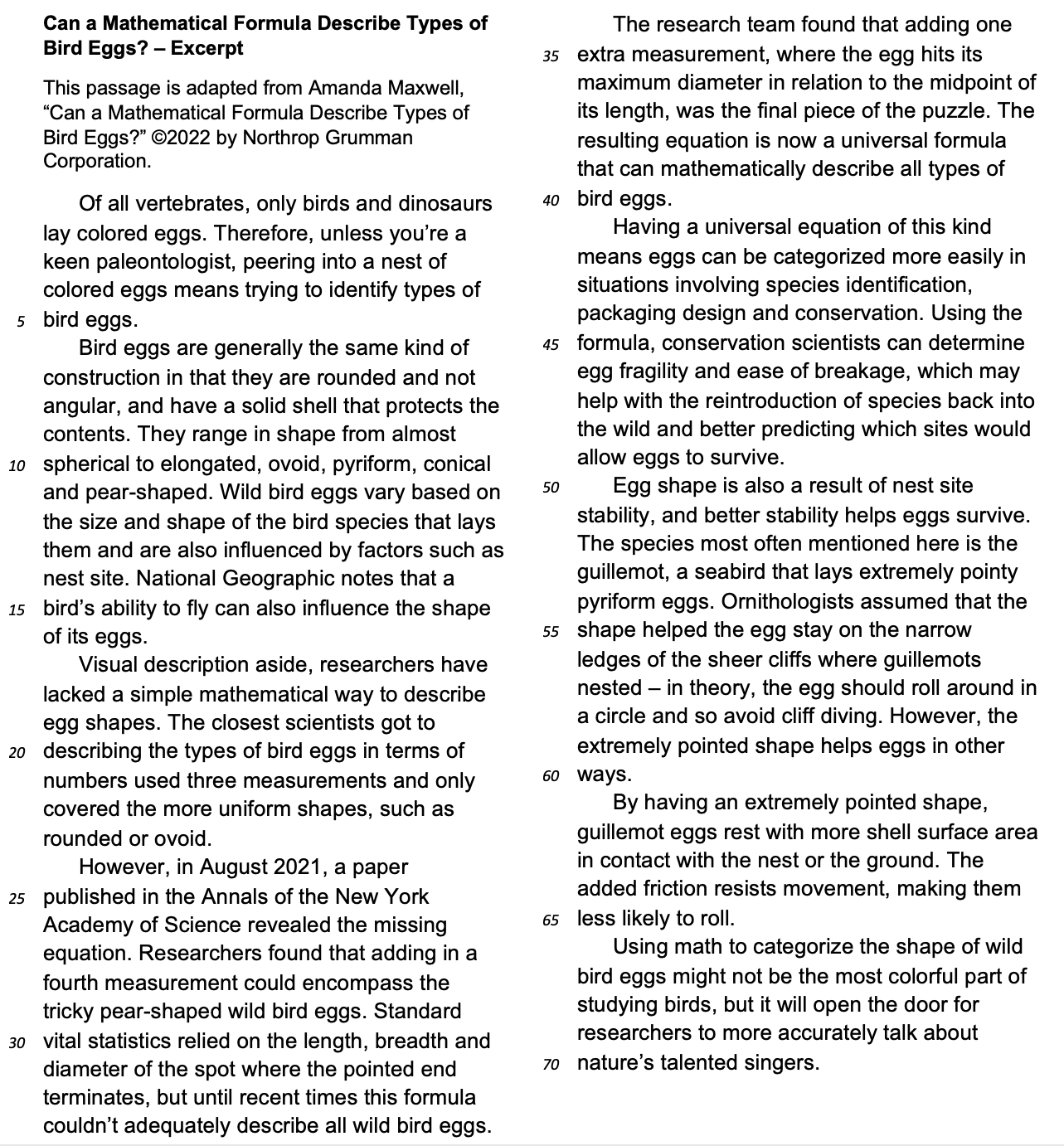
Reading Comprehension Questions
1. Which of the following is not said to influence egg shape?
A. The site of the nest.
B. The ease for baby birds to hatch.
C. The size of the bird species.
D. The bird’s ability to fly.
2. The passage states, “Bird eggs are generally the same kind of construction in that they are rounded and not angular…” (lines 6-8). Based on the passage, which of the following is the most likely reason as to why eggs are rounded and not angular?
A. Angular eggs would have to be larger, making the outer shell thinner.
B. Rounded eggs are more comfortable for bird mothers to lay upon in a nest.
C. Angular eggs would have a greater risk of cracking, due to sharper edges.
D. Rounded eggs are smaller, so more are able to fit inside a nest.
3. “Pyriform” (line 54) most nearly means
A. pyramid-shaped.
B. fire-red.
C. five-layered.
D. pear-shaped.
Passage Answer Key and Explanations
1. B.
B. The ease for baby birds to hatch is the correct answer because it is not indicated in the text. The passage describes certain factors that influence the size and shape of bird eggs: “Wild bird eggs vary based on the size and shape of the bird species that lays them and are also influenced by factors such as nest site. National Geographic notes that a bird’s ability to fly can also influence the shape of its eggs,” (lines 11–16). This textual evidence indicates that answers A, C, and D are all valid influencers of egg shape; ease of hatching is not mentioned in the text.
2. C.
C. Angular eggs would have a greater risk of cracking, due to sharper edges is the correct answer choice. The passage provides several details indicating that egg shape is very connected with egg fragility and prevents the egg from cracking. The author writes, “Egg shape is also a result of nest site stability, and better stability helps eggs survive,” (lines 50–51). They then describe that guillemot eggs lay very pointy eggs—since all eggs are rounded and not angular (lines 11–14), we can picture this as a cone shape with a rounded tip and base, hypothesized to“…[help] the egg stay on the narrow ledges of the sheer cliffs where guillemots nested”, preventing the egg from falling off the cliffs (lines 55–58). We can clearly see that a major factor of an egg’s shape is what shape will help keep the egg safe.
No evidence from the passage points to the idea that angular eggs would be larger—as a result, A and D can be eliminated. B somewhat makes sense, but there is no evidence in the passage that supports it. Thus, C is the correct answer choice. Angular objects have edges—if the objects are fragile, like bird eggs, the edges could easily crack.
3. D.
D. Pear-shaped is the correct answer choice.
This question can be evaluated by looking at both the parts of the word and the context of the word.
The structure of “pyriform” hints that it has to do with shape/structure—“-form” is a Latin root meaning shape, such as in formation. This lets us rule out “B. Fire-red”, as it deals with color, and “C. Five-layered”.
The context for “pyriform” is: “Egg shape is also a result of nest site stability, and better stability helps eggs survive. The species most often mentioned here is the guillemot, a seabird that lays extremely pointy pyriform eggs,” (lines 50–54). As you can see, “pyriform” is paired with “pointy”. This may lead you to believe that the correct answer is A; however, remember that this is an egg. As described in the second paragraph, all bird eggs are rounded and not angular, so there is no way for them to be “pyramid-shaped”. We now know that these “pyriform” eggs are pointy yet rounded in shape. The remaining answer choice reveals the form: “pear-shaped”.
Read the full article: “Can a Mathematical Formula Describe Types of Bird Eggs?”
Easter Math Quiz: Coordinates, Sequences, and Interest
Want a few more ways to work your students’ math skills in celebration of Easter? Piqosity’s math team has developed the following mathematics questions covering a variety of subtopics to test students on some crucial math skills while maintaining a seasonal bent. Print out copies of this section and you’ve got ready-made Easter math worksheets to hand out to your students!
Original Easter Math Questions by Piqosity
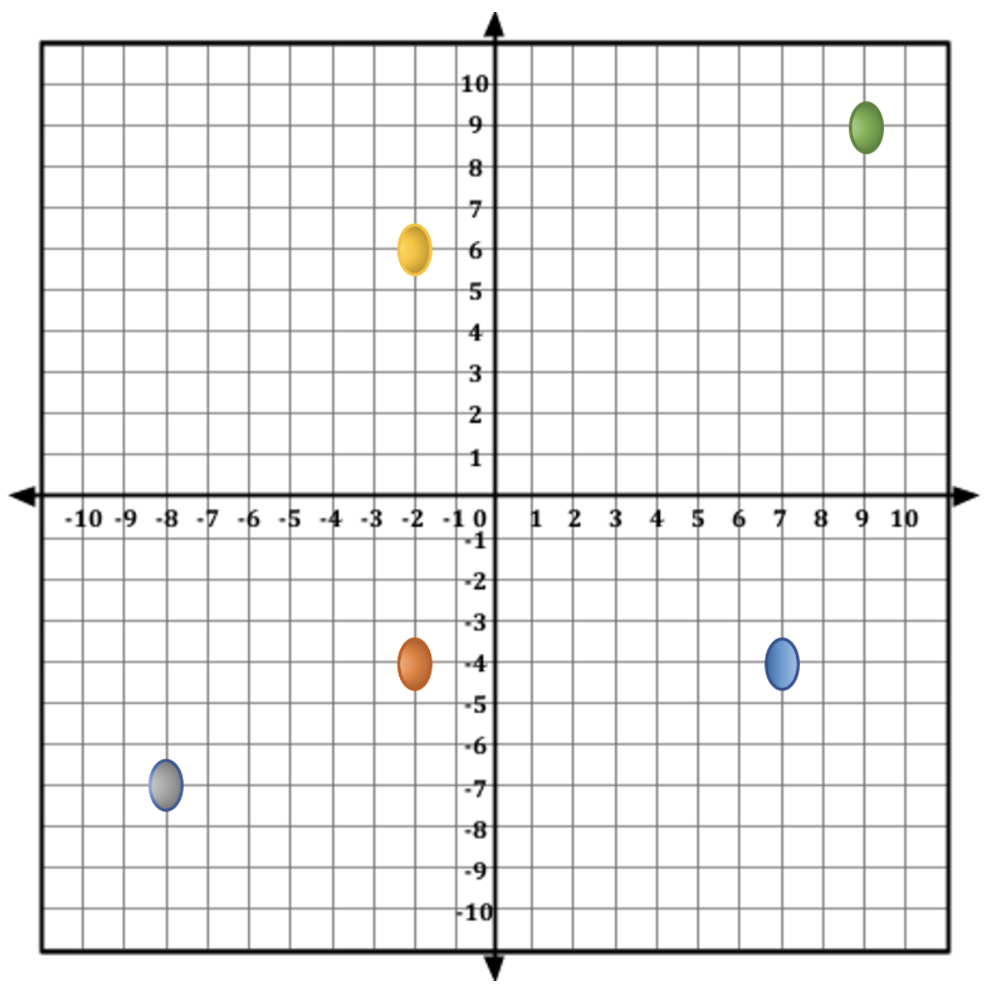
1. An easter bunny hides some eggs in a neighborhood and records their positions on the graph shown above. Which of the following solution sets contains the locations of all the eggs?
A. {(−9, −9), (−7, 6), (2, 4), (8, 7), (2, −6)}
B. {(9, 9), (−6, 7), (−4, −2), (−7, −8), (6, −2)}
C. {(9, 9), (7, −6), (−2, −4), (−8, −7), (−2, 6)}
D. None of the above.
2. Easter Sunday is the first Sunday after the first full moon starting after March 21st each year. If the full moon falls on a Sunday, Easter will be celebrated on the following Sunday. March 21st, 2023 fell on a Tuesday. If Monday March 7th 2023 was a full moon, when did Easter Sunday fall in 2023?
A. Sunday, April 9th 2023
B. Wednesday, April 5th 2023
C. Sunday, April 16th 2023
D. None of these.
3. This year, Jonathan decides to plant 2 daffodils in his backyard. Over the next year, the population of daffodils grows exponentially at a rate of 75%. Which of the following is equal to the approximate number of daffodils in Jonathan’s backyard after one year?
A. 18
B. 4
C. 16
D. 6
Original Math Questions Answer Key and Explanations
1. C. {(9, 9), (7, −6), (−2, −4), (−8, −7), (−2, 6)}
To find the coordinates of a point plotted in a coordinate plane, we need to first find the distance from the origin we travel horizontally and then vertically to reach that point.
The correct solution set is: C. {(9, 9), (7, −6), (−2, −4), (−8, −7), (−2, 6)}.
2. A. Sunday, April 9th 2023
If Monday, March 7th, 2023 was a full moon, the next full moon fell on Wednesday, April 5th, 2023. (29.5 days later)
This means that the next Easter Sunday was the first Sunday after Wednesday, April 5th.
This means that Easter Sunday in 2023 fell on (A.) Sunday, April 9th, 2023.
3. B. 4
The population of daffodils is growing at an exponential rate. To calculate the number of daffodils present after 1 year, we will need to use the exponential growth formula:
Where A is the target or final value, P is the principal or initial value, e is Euler’s number (approximately equal to 2.718), r is the growth rate and t is the number of years over which we are evaluating.
In this case, our growth rate is 75%. Convert this value to a decimal before plugging it into the formula.
75% = 0.75
This means that there will be approximately 4 daffodils in Jonathan’s backyard after one year.
Find More ELA and Math Resources Like These at Piqosity!
We hope you’ve found these Easter activities for the classroom resourceful and insightful, both in their engaging celebration of the holiday and in the plentiful opportunities to sharpen key ELA and math skills for students.
If your students are in need of extra help with ELA or math skills, Piqosity is here to help! Along with our Digital SAT and ACT test prep courses, each packed with several full-length practice tests, we also offer full-length online English and Math courses—each course includes dozens of concept lessons, personalized practice software, and practice tests with step-by-step answer explanations.
The best part? You can try out all of Piqosity’s features with our free community account, which features a free mini diagnostic exam to evaluate your current math skills. When you’re ready to upgrade, Piqosity’s year-long accounts start at only $89.


